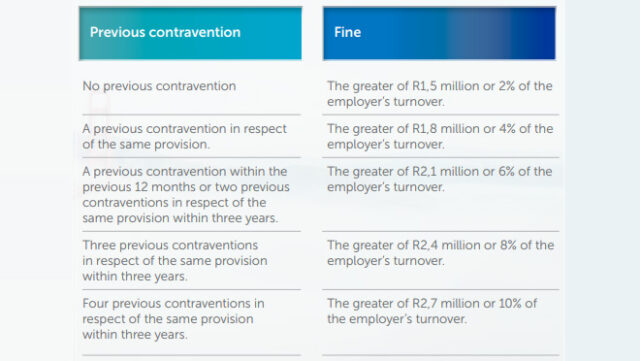In a twist on the old movie industry saying of “hurry up and wait”, designated employers who have been waiting for clarity on the employment equity regulations must now shift into high gear. The long-awaited regulations have officially come into effect, signalling a move from voluntary to mandatory compliance as of 15 April.
The 2025 Employment Equity Act (EEA) Regulations significantly raise the bar for compliance, introducing stricter enforcement mechanisms and placing a sharp focus on sector-specific numerical targets that must be met over a five-year period.
Designated employers – those with 50 or more employees or organs of state, regardless of staff size – are now required to develop and implement an Employment Equity Plan for the period 1 September 2025 to 31 August 2030. Employers who become designated after 1 April 2025 will need to draft a plan covering the remainder of this five-year timeframe.
According to the fifth edition of the Employment Equity Amendments and 2025 EEA Regulations Guideline, published by law firm Cliffe Dekker Hofmeyr (CDH), employers have until 31 August 2025 to conduct a workplace analysis and either draft new or amend existing Employment Equity Plans to align with the amended legislative framework and prescribed sector targets.
The 2025 reporting period opens on 1 September 2025 and runs until 15 January 2026. During this window, the Department of Employment and Labour (DoEL) will begin issuing the first certificates of compliance.
However, employers will not be assessed on their progress towards achieving the five-year sectoral targets during this initial cycle. That changes in 2026. From 1 September 2026 to 15 January 2027, employers will undergo their first evaluation against the annual targets as part of assessing their progress in achieving the five-year goals.
Designated employers and sectoral targets
On 15 April, the Minister of Employment and Labour, Nomakhosazana Meth, released the final versions of the Determination of Sectoral Numerical Targets and the Employment Equity Regulations 2025. Together, these are referred to as the 2025 EEA Regulations. They replace the 2014 regulations and follow the implementation of the Employment Equity Amendment Act of 2022, which officially came into force on 1 January 2025.
According to CDH, the EEA applies broadly to all employers operating in South Africa, excluding the military, intelligence services, and secret service. However, sections 12 to 27 – covering affirmative action – apply only to “designated employers”, a group now narrowed by the Amendment Act.
The revised definition excludes employers with fewer than 50 employees, regardless of turnover, easing the compliance burden on small businesses. Although these smaller employers are exempt from submitting equity plans and reports, they may still apply for a compliance certificate under section 53 of the EEA – but more on that later.
The updated General Administrative EE Regulations provide standardised forms for reporting (EEA2 and EEA4), templates for equity analysis and planning (EEA12 and EEA13), and details about compliance certification. These tools aim to help employers understand and apply the new rules more easily, whether they are designated or non-designated employers.
The final sector target regulations set out five-year numerical employment equity targets for “designated groups” across 18 economic sectors, including finance, manufacturing, healthcare, education, and construction.
Each sector has a single set of targets based on gender and covering four upper occupational levels: top and senior management, professionally qualified and middle management, and skilled technical roles. People with disabilities are also included, without further breakdown by race or gender.
No targets have been set for semi-skilled and unskilled positions. However, employers must consider national or provincial Economically Active Population (EAP) figures when developing equity plans for these levels.
The targets aim to increase representation of “designated groups” – black South Africans (including Africans, Coloureds, and Indians), women, and persons with disabilities – defined in the EEA.
Legal experts from Werksmans note that the new approach moves away from the previous method of setting targets per racial group using EAP data.
“This is a departure from the manner in which designated employers previously had to set targets using the Economic Active Population, whereby designated employers had to set targets based on each specific racial group,” write Anastasia Vatalidis, Kerry Fredericks, and Gracie Sargood.
Importantly, the targets are not meant to total 100%, acknowledging that white men and foreign nationals will continue to be employed.
Bowmans’ Talita Laubscher and Melissa Cogger note that designated employers must set annual numerical targets aligned with the five-year sectoral goals, the EAP, and the representation of persons with disabilities.
“The General Administrative EE Regulations state that the manner in which designated employers must take the sector targets into account and apply the affirmative action measures is set out in the EEA, the General Administrative EE Regulations, and the codes of good practice issued under the EEA.”
Laubscher and Cogger add that over-representation must be addressed: “The 2025 General Administrative EE Regulations discourage designated employers from perpetuating the over-representation of any group if their representation exceeds the applicable EAP in a particular occupational level.”
In cases where a designated group’s target is already met or exceeded, employers must still set targets to maintain EAP compliance. Notably, the final regulations remove the draft 2024 ban on “regression” in representation.
Employers operating across multiple provinces can now apply different provincial EAPs to reflect regional workforce demographics – a flexibility absent from the previous draft regulations.
Certificates of compliance
From 1 September 2025, designated employers will begin the first reporting cycle under the amended EEA, which ends on 15 January 2026. For the first time, certificates of compliance will be issued by the DoEL – a requirement for doing business with the state.
These certificates, valid for 12 months, confirm that an employer has met its employment equity obligations, including adherence to the sectoral numerical targets or providing valid reasons for not doing so. Additional requirements include submitting an annual report, having no findings of unfair discrimination or minimum wage breaches in the past year, and complying with the National Minimum Wage Act.
Section 53 of the Act, now operationalised by the 2025 Regulations, outlines the application process for a compliance certificate, which must be submitted online. Both designated employers and non-designated employers may apply. Non-designated employers must declare compliance with relevant legislation using the EEA15 form.
If an employer falls short of any requirement, it must provide justifiable reasons in its application.
Once approved, certificates will be issued as EEA16A (for designated employers) or EEA16B (for non-designated employers).
Certificates may be withdrawn by the minister, a labour inspector, or a delegated DoEL official if issued based on misrepresentation or if the qualifying conditions no longer exist. However, withdrawal can only occur after the employer is given 14 days to respond to a formal notice.
Justifiable reasons protect employers from penalties for missing EE targets
If an employer falls short of either the annual numerical targets or the five-year sectoral numerical targets, it must provide justifiable reasons in its application.
Werksmans notes that a designated employer will incur no penalty or disadvantage if there are reasonable grounds to justify its failure to comply with any target.
The justifiable reasons for non-compliance are repeated in the General Administrative EE Regulations, which remain unchanged from the Draft 2024 Sector Targets.
There are seven justifiable reasons for a designated employer’s failure to comply with its targets as set out in its Employment Equity Plan.
These are:
- insufficient recruitment opportunities;
- insufficient promotion opportunities;
- insufficient target individuals from designated groups with relevant formal qualification, prior learning, relevant experience or capacity to acquire, within a reasonable time, the ability to do the job, as contemplated by sections 20(3) to (5) of the Act;
- the impact of a CCMA award or court order;
- a transfer of a business;
- mergers or acquisitions; and
- the impact of economic conditions on the business.
Steep fines under new rules
Designated employers that fail to meet sectoral numerical targets under the amended EEA could face financial penalties if they cannot provide valid reasons for their non-compliance, according to Werksmans.
CDH adds that although the EEA allows labour inspectors to issue compliance orders for certain failures – such as not consulting with employees or not submitting employment equity plans – sections 15 and 15A, which deal specifically with sectoral targets, are excluded from this enforcement mechanism. This means non-compliance with these targets cannot be addressed through a compliance order.
However, an amendment to section 42 of the EEA now requires the Director-General to assess whether an employer has met the sectoral targets. If not, and the employer cannot justify its non-compliance, section 45 empowers the Director-General to seek an order from the Labour Court compelling compliance – or to impose fines as outlined in Schedule 1 of the Act.
These penalties follow a sliding scale based on the employer’s previous contraventions and effectively treat failure to meet sectoral targets as seriously as failing to implement an employment equity plan.

Werksmans has cautioned that failure to comply could result in substantial monetary penalties and other enforcement actions.
Bowmans has echoed this sentiment, noting that the enforcement of sectoral targets will significantly affect designated employers, particularly those seeking to do business with the state.
Understanding these targets – and how they apply to individual businesses – will be critical for employers hoping to avoid sanctions and maintain eligibility for government contracts.




Any successful business employs those most qualified and efficient in the given position. To be forced to employ unsuitable candidates just based on colour is ridiculous and will lead to even greater departure of those skilled persons to countries with fair labour practices. ANC is shooting themselves in the foot!!